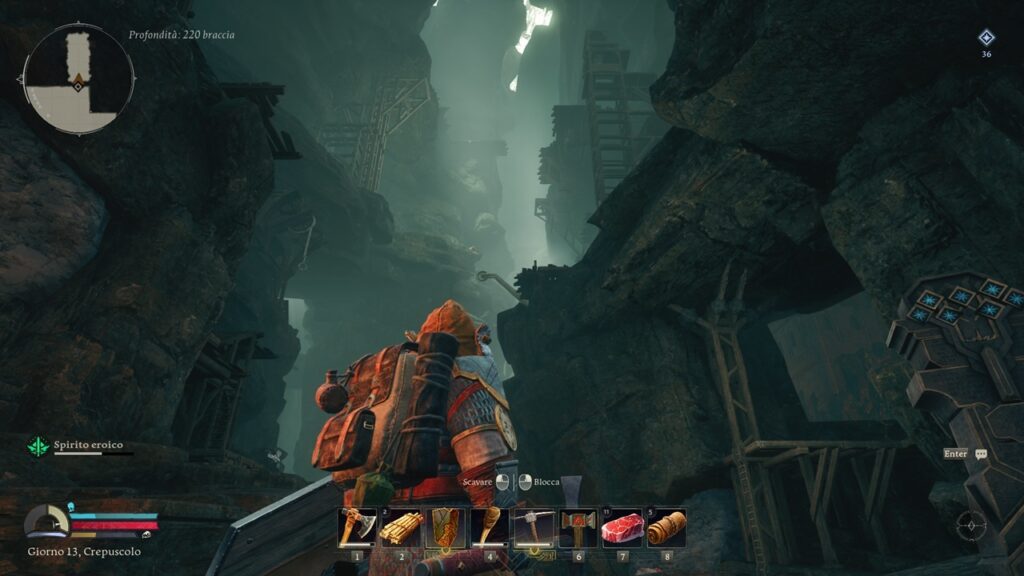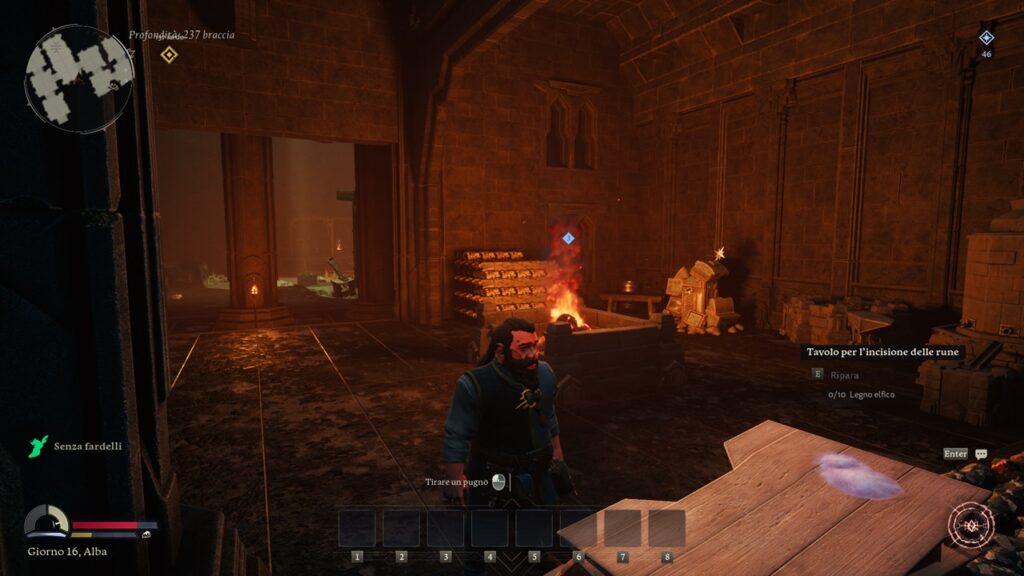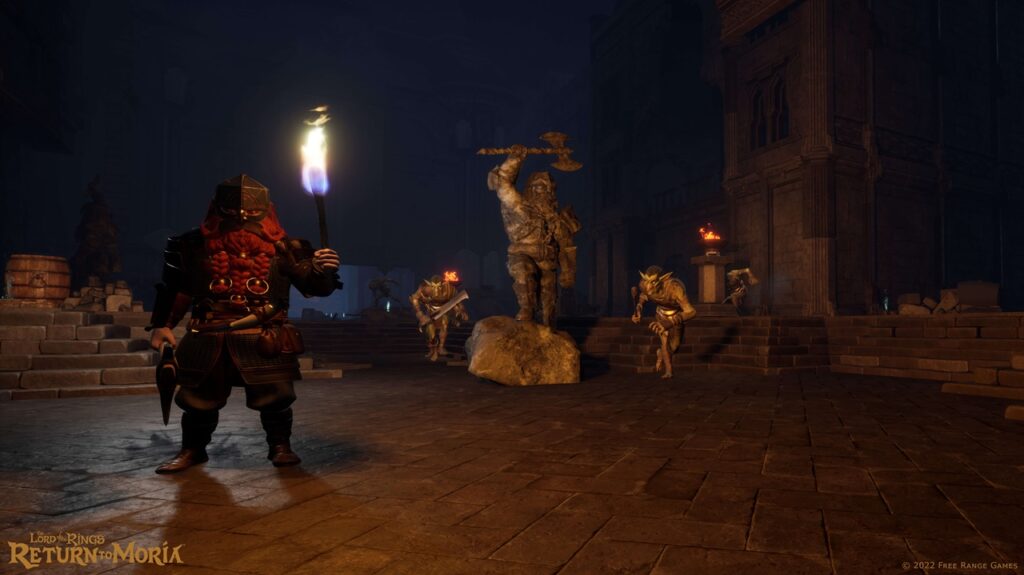The Lord of the Rings it is undoubtedly one of those sagas capable of transcending the passage of time and continue, after almost 70 years, to make millions of fans all over the world dream. The fortune of the literary trilogy has experienced an extraordinary expansion over the years, touching practically all the media at our disposal. Even video games are no exception and although they have fallen asleep in recent years, if we do not open the sad parenthesis of Gollum, continues to have a strong interest in Middle-earth. Today, in fact, we are here to talk to you in this review of The Lord of The Rings: Return to Moria, the new title set in the fascinating world of Arda.
The Lord of The Rings: Return to Moria è un survival game which has as its protagonistto the dwarven people and is developed by Free Range Games e North Beach Games. Collection of resources, combat and construction are the main features as in every title belonging to the survival genre, but will Return to Moria be able to differentiate itself?
Our review of The Lord of the Rings: Return to Moria
Return to Moria is set in the Fourth Age of Middle-earth, after the defeat of Sauron and the destruction of the One Ring. Although the Dark Lord has been eliminated, the legacies of his evil influence are still alive in the world but this will not stop the Dwarven people from embarking on a major campaign: recapture the mines of Moria. The kingdom of Khazad-dûm had in fact fallen several years earlier when the Dwarves awakened an ancient Balrog di Morgoth digging “too deeply and too greedily.” At the head of this expedition is the Dwarf Gimli, the bearer of the Cioccawho will lead a company of Dwarves to reclaim the lost kingdom of Moria.
The mission, needless to say, turns out to be more complex than expected. To the natural difficulties of such an impractical and, moreover, ruined place, are added handfuls of goblins, orcs and trolls who took refuge here after the defeat of their master. While we explore the mines we will therefore have to accumulate resources to rebuild what has been lost, manage our camps, develop equipment for our adventure, eat and so on.
Do you think it’s too much? The Shadow of the Realm of Nanosterro hides much more dangerous dangers and a mysterious curse blocks some passages, poisoning anyone who approaches. Luckily, the Balrog of Moria was defeated some time ago…Right?!
The revenge of the dwarves
Once our campaign has started, we will have the opportunity to ccreate and customize the Nano which will contribute to the reconstruction of Moria. The Character Creator, focused only on aesthetic elements, provides few elements which however manage to give uniqueness to your Nano (yes, even with a beard) protagonist of the story. You can decide whether to start playing in single-player (offline) or in online multi-player along with other dwarf companions. In both cases, we will soon find ourselves separated from Gimli and his team and will have to face this great adventure alone (or with our group of friends).
As a good Survival Game, the aim of the game is to collect resources to build our camps, improve equipment and continue deeper into the mines. The latter are indeed rich in dangers but also in resources. Not only stones and minerals, lots of minerals, but also trees, animals that adapted to the environment and everything that survived before the ruin of the mines. Of course it will also be possible work resources to obtain new ones through the forge, the forge, and all that dwarven culture has to offer. Despite the current situation in Moria, the past of the Dwarves is more alive than ever and the ancient glories must be brought back to life. This will allow us to learn new recipes to build stronger and more resistant objects and equipment.
Weapons, armour, helmets and backpacks will be the main tools to face the many enemies that infest the dungeons and which will periodically attack our bases. From a simple pickaxe, we will have the possibility to take up powerful axes or rapid bows to defend ourselves and attack to acquire new resources and spaces. Speaking of spaces, the game map is procedurally generated which means that each new game will always have a different map and development, except for central points that affect the plot.
A great classic but always a winner
At this point, you will certainly have guessed that The Lord of The Rings: Return to Moria brings with it all the basic functions of a classic Survival Game with some original touches here and there, but without overdoing it. The formula “Collect-Build-Fight” it remains the same throughout the game but also represents its strong point. Seeing our camp grow and bring back the glory of Moria will give you a pleasant sense of satisfaction. To this we add one well-developed main plot (although not the core of the gameplay) that will entice you to continue playing.
The gathering and crafting system respect the rules of the genre. Both the resources to collect and the objects to develop are many. From weapons to equipment, from walls to the structures of our humble dwarven home, we will have dozens and dozens of recipes available, some of which are not at all simple to develop.
The combat also features fairly standard mechanics. Depending on the weapon available we can carry out simple or charged attacks to knock down enemies, aim them, block blows or dodge them by rolling away. For the more challenging enemies (no spoilers!), an extra dose of strategy will be necessary which mostly translates into exploiting the awkwardness of the movement mechanics and rendering of space and its obstacles that the survival genre cannot manage to shake off.
The charm of Tolkien’s world
As we progressed with the game, we realized that the real strength of this title is the world we find ourselves in, the original story that is presented to us and the world in which it is made. We are not a banal character X who must survive difficulties in a land Y, we are a Dwarf from Moria! Throughout the game we will encounter elements and documents immersed in the incredible lore that Middle-earth offers us with references to events from the past, which we know, and events from the future, which have never been told.
We will happen, for example, to find old camps of Balin’s ill-fated company, or letters from Gandalf and the Fellowship of the Ring who passed through the same halls in the Third Age. Every element exudes “Tolkien” from every pore and being original content, i.e. never told by Tolkien’s writings, the risk of distorting the plot was very strong (hello Amazon!) but this did not happen.
The developers have in fact consulted Corey Olsen, T. S: Luikart and David Salo, scholars and experts in the Tolkien world to maintain possible coherence with Tolkien’s writings and even to create new sentences in Khuzdul, the language of the dwarves. The result is a beautiful mix of originality and respect for the saga that we can only praise. And this is how after collecting ore for a while we could make our dwarves sing a melodious tavern ballad.
The technique of the dwarves
As in most Survival Games, the graphics in The Lord of The Rings: Return to Moria don’t shine. Both to cope with the procedural nature of the map and its vastness, animations and textures are rather antiquated. Despite the lack of details, the rendering of Moria is excellent and the various biomes that characterize it are represented at their best and with characteristic and well-considered elements. However, the lack of technical complexity of the game makes it extremely fluid even in systems that are not too high-performance. In this regard, we have never encountered major bugs or glitches that ruined the gaming experience.
From an audio point of view, some elements did not particularly convince us. We had the impression several times that there should be a lot more SFX, especially during combat or construction, which significantly reduced the level of immersion. However, the situation is different for the music, which is also inspired by Tolkien’s works and particularly apt.
Of note is the absence of dubbing in Italian but an excellent localization of the texts which do not present any errors. Obviously we cannot fail to mention and appreciate the return of John Rhys-Davies who resumes his role as Gimli dubbing him.
La recensione di The Lord of The Rings: Return to Moria in breve
The Lord of The Rings: Return to Moria is the Tolkenian revival of the survival genre that does not differ too much from the genre. It will remind you of titles like Valheim or Rust on several occasions and the few original elements, such as the light and noise mechanics (which we’ll let you discover), are not enough to make it stand out from the crowd.
What saves it and what enchanted us as big Tolkien fans is the setting and the story in perfect line with Middle-earth. We truly felt like Dwarves on a mission and we weren’t collecting normal resources, but minerals and Mithril from the mines and we weren’t fighting random beasts, but Goblins and Orcs who had escaped from Mordor.
Everything translates into an excellent mix where classic gameplay meets an original plot, all immersed in the always pleasant and more alive than ever world of Tolkien.
















Leave a Reply
View Comments